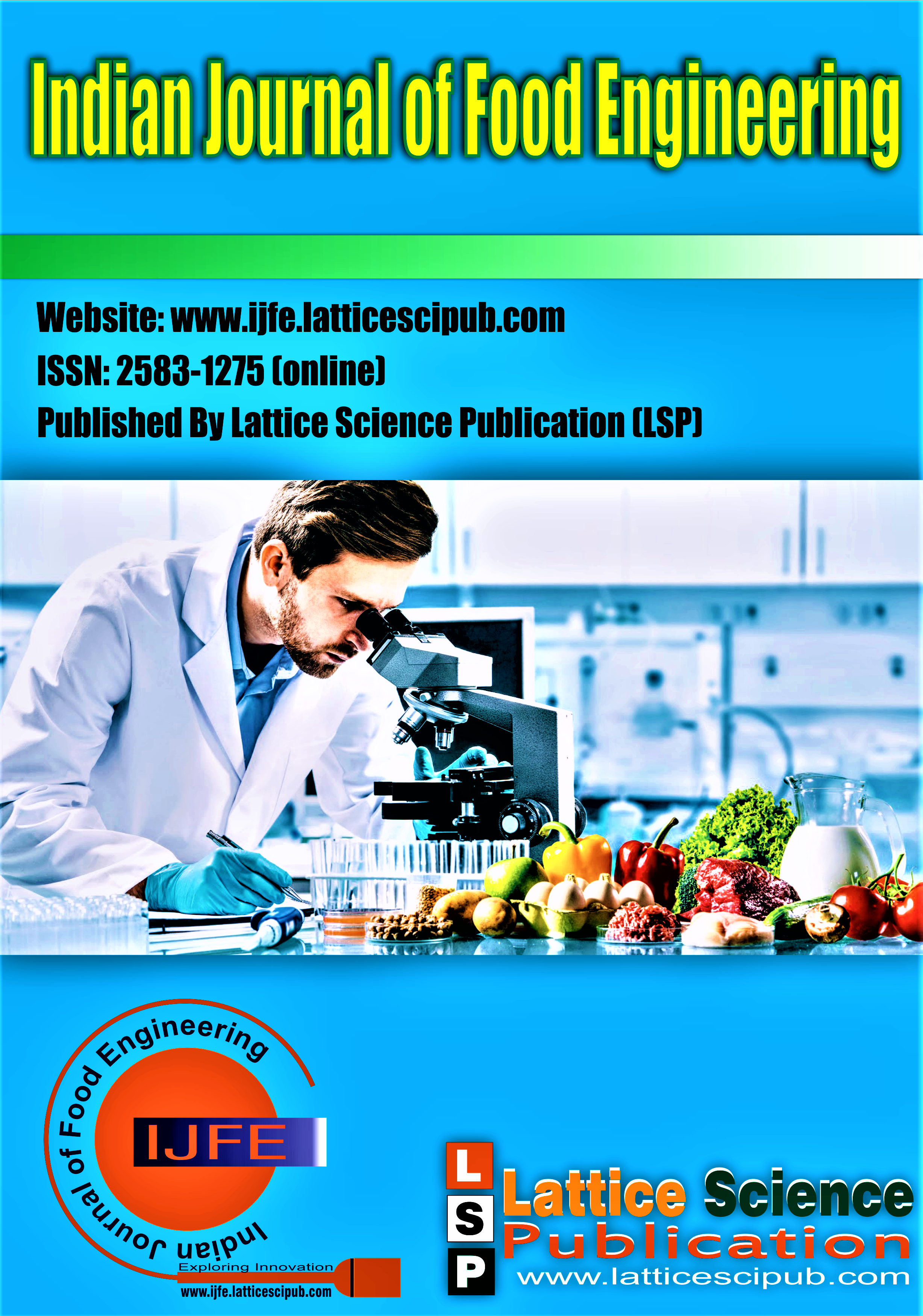The Dynamic Role of Ultrasonic Treatment Technology in Flax Seed for the Development of Fortified Mushroom Powder to Boost Nutritional Benefits in Drink Development
Main Article Content
Abstract
This study investigated the physicochemical properties and sensory acceptability of fortified mushroom smoothies using blends of Agaricus bisporus with chia, flax, and pumpkin seeds. Standard analytical techniques and Pearson's correlations were used to examine blends containing different levels of mushroom flour (10%, 15%, 20%, 25%, and 30%). The findings revealed that increasing the mushroom content led to higher levels of protein, ash, fiber, zinc, and iron in both the composite flours and fortified smoothies. Additionally, the in vitro protein digestibility of the fortified smoothies improved with increased mushroom content. Adding P. ostreatus flour resulted in higher pH and lower total titratable acidity (TTA), whereas A. bisporus flour had the opposite effect. Moreover, higher mushroom content decreases fat, carbohydrates, and energy in the flours and smoothies, as well as reducing the viscosity of the fortified smoothies. Positive linear effects on foaming capacity, foam stability, fat absorption capacity, water retention capacity, water absorption capacity, solubility index, and swelling capacity were observed. At the same time, compact density, bulk density, and syneresis showed negative linear effects. The gelation capacity, emulsifying activity, and emulsion stability remained unaffected by P. ostreatus but slightly decreased with A. bisporus. The study highlights the potential of mushroom flours as a novel food fortification, given their nutritional benefits and numerous health-promoting attributes. (R.M. Ishara Jackson1, Daniel N. Sila2, Glaston M. Kenji2) (2018) [1].
Downloads
Article Details

This work is licensed under a Creative Commons Attribution-NonCommercial-NoDerivatives 4.0 International License.
How to Cite
References
Edible Mushrooms: Novel Food Fortification Approach Towards Food Security R.M. Ishara Jackson¹, Daniel N. Sila², Glaston M. Kenji² 1Universit´e Evang´elique en Afrique (UEA), Food Science and Technology, DR Congo 2Jomo Kenyatta Univ. of Agriculture and Technology, Food Sci. & Techn., Kenya (2018).
Chang, S.T.; Miles, P.G. Mushrooms: Cultivation, Nutritional Value, Medicinal Effect, and Environmental Impact, 2nd ed.; CRC Press: Boca Raton, FL, USA, 2008.
Ergönül, P.G.; Akata, I.; Kalyoncu, F.; Ergönül, B. Fatty acid compositions of six wild edible mushroom species. Sci. World J. 2013, 2013, 163964. https://doi.org/10.1155/2013/163964
Guillamón, E.; García-Lafuente, A.; Lozano, M.; D’Arrigo, M.; Rostagno, M.A.; Villares, A.; Martínez, J.A. Edible mushrooms: Role in the prevention of cardiovascular diseases. Fitoterapia, 81, 715–723. https://doi.org/10.1016/j.fitote.2010.06.005
Longvah, T.; Deosthale, Y.G. Composition and nutritional studies on edible wild mushroom from Northeast India. Food Chem. 1998, 63, 331–334. https://doi.org/10.1016/S0308-8146(98)00026-0
Maga, J.A. Mushroom flavor. J. Agric. Food Chem. 1981, 29, 1–4. https://doi.org/10.1021/jf00103a001
Mattila, P.; Konko, K.; Euvola, M.; Pihlava, J.; Astola, J.; Vahteristo, L. Contents of vitamins, mineral elements and some phenolic compound in cultivated mushrooms. J. Agric. Food Chem. 2001, 42, 2449–2453.
Bano, Z.; Rajarathnam, S. Pleurotus mushrooms. Part II. Chemical composition, nutritional value, post-harvest physiology, preservation, and role as human food. Crit. Rev. Food Sci. Nutr. 1988, 27, 87–158. [CrossRef] J. Fungi 2021, 7, 427 14 of 18https://doi.org/10.1080/10408398809527480
Stamets, P. (2005). Notes on nutritional properties of culinary-medicinal mushrooms. I. J. of Medicinal Mushrooms. 7: 103-110. https://doi.org/10.1615/IntJMedMushr.v7.i12.100
Manzi, P.S., Marconi, A. A., Pizzoferrato, L. (2004). Commercial mushroom nutritional quality and effect of cooking. Food Chem. 84: 201-206. https://doi.org/10.1016/S0308-8146(03)00202-4
Mohammed & Alhajhoj, 2019. Importance and Applications of Ultrasonic Technology to Improve Food Qualityhttps://doi.org/10.5772/intechopen.88523
Thakur et al. (2021), Improving production of plant secondary metabolites through biotic and abiotic elicitation. December 2018 Journal of Applied Research on Medicinal and Aromatic Plants 12(7). https://doi.org/10.1016/j.jarmap.2018.11.004
Verma, Prof. K. (2024). Dynamic Jobs of Ladies in the Development of Consumable and Restorative Mushrooms of Focal India as a Pay Age Movement. In Indian Journal of Food Engineering (Vol. 3, Issue 3, pp. 6–14). https://doi.org/10.54105/ijfe.c1014.03030624
Nuanmeesri, S., & Sriurai, W. (2019). Development of the Edible and Poisonous Mushrooms Classification Model by using the Feature Selection and the Decision Tree Techniques. In International Journal of Engineering and Advanced Technology (Vol. 9, Issue 2, pp. 3061–3066). https://doi.org/10.35940/ijeat.b4115.129219
Thangavel R, Power Quality Recommendations in Mushroom Farm. (2019). In International Journal of Innovative Technology and Exploring Engineering (Vol. 9, Issue 1, pp. 5041–5043). https://doi.org/10.35940/ijitee.a5256.119119





